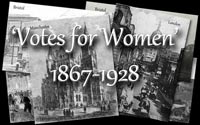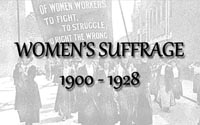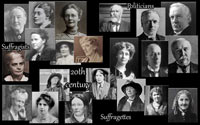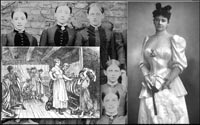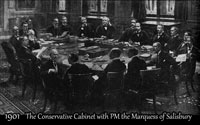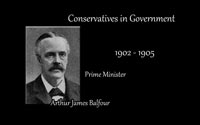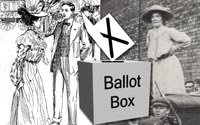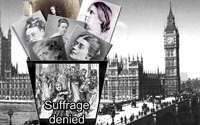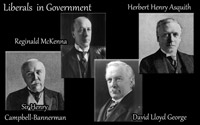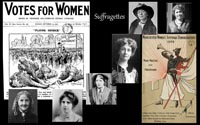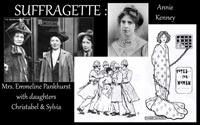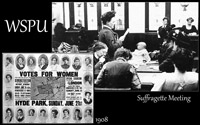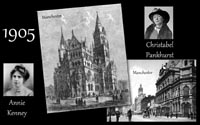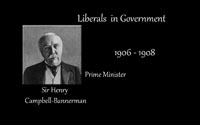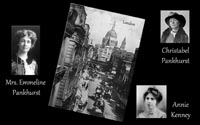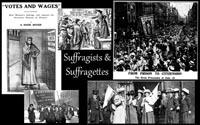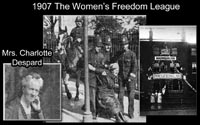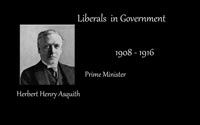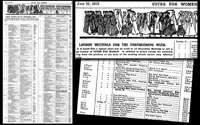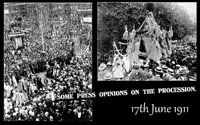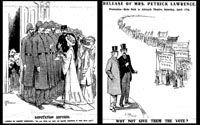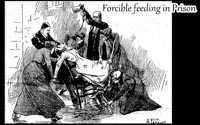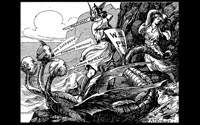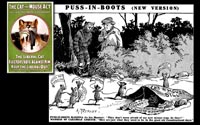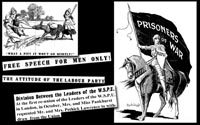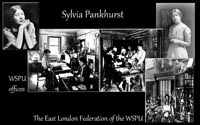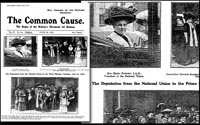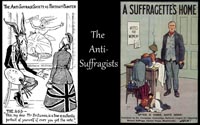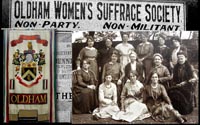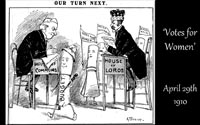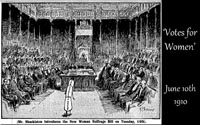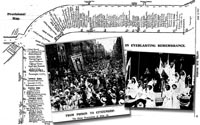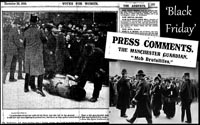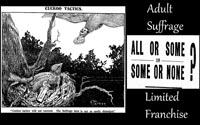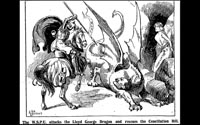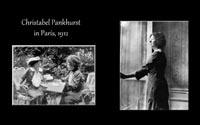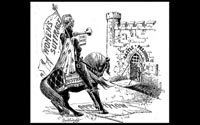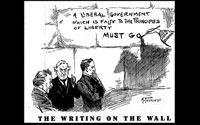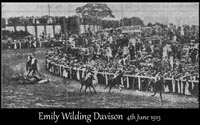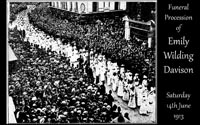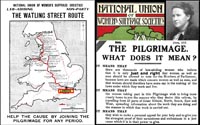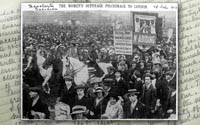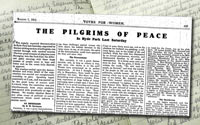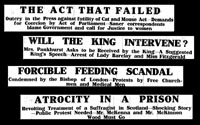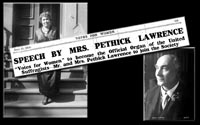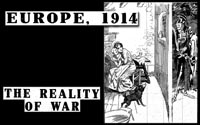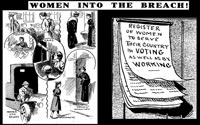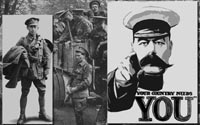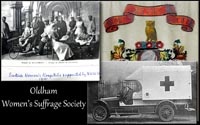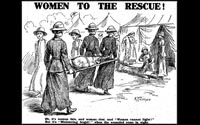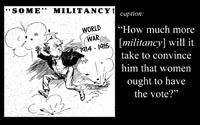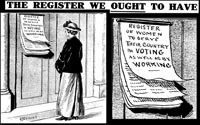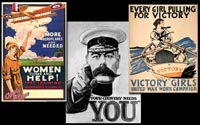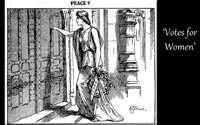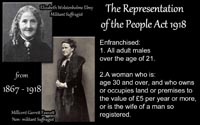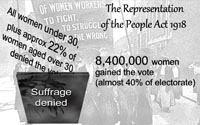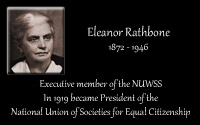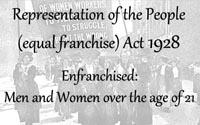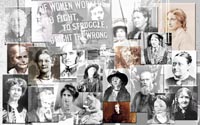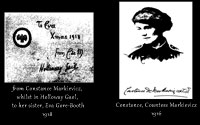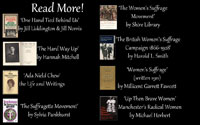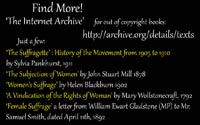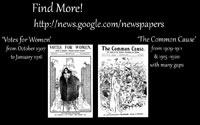
"VOTES FOR WOMEN!" - |
||
CHRONOLOGY of events Opens in a new window |
||
PART 2 .......... 1900 - 1928
|
||
A new century, bringing new beginnings .......... |
||
It's extremely difficult to do unbiased justice to the Campaign for Women's Suffrage from 1900 to 1928, with just a brief look at it ......... Sylvia Pankhurst's book, 'The Suffragette Movement' fills over 600 pages with detail! The best I can hope to do is give you some insight and hope that it can make you want to fill in the detail for yourself ........... |
||
The Second part of the campaign would be different from that of the Victorian era ..... 'Persistence' and 'Persuasion', with reluctant' Patience', had been the previous tactics for change. The early movement hadn't touched the lives of working women ..... it wasn't happening in their streets, or 'Downstairs' in the big houses ......... it was happening 'Upstairs' and in the Corridors of Power.Most women, catching perhaps a glimpse of the campaign, would have felt it had nothing to do with them .........Changes, for working women, that had begun slowly, in the last few years of the 19th century would turn into a gallop as women across all classes of society realised the injustice of their situation and set about changing it .......... but not always by the same methods. |
||
to set the scene for the next 28 years of struggle ........... In 1901 Queen Victoria died and Edward VII came to the throne. The Conservatives, with the Marquess of Salisbury as Prime Minister were still in Government. and would remain so until the General election of 1906 swept the Liberals to power with a large majority. |
||
In the following year, in 1902, an ailing Salisbury resigned as Prime Minister in favour of his nephew, Arthur James Balfour. |
||
In the first years of the new century the NUWSS began to change from a society dominated by middle class, mainly London women, to a national movement with a membership of women from across all professional, religious, employment and class backgrounds. Without any formal party affiliation, their focus shifted, from lobbying elected MPs in Parliament, to the constituencies, and influencing the selection of prospective, pro-suffrage, parliamentary candidates. There was a continuation of meetings, debates, deputations, campaigning, writing articles and leaflets, and spreading the suffrage message as far and wide as possible. Hopes ran high for changes ........ |
||
The penultimate hurdle obstructing Women's suffrage was the determination of the terms on which women's suffrage would be acceptable to all parties and the final hurdle would be to find the means of forcing a government to either introduce the necessary legislation or, at the very least, not put obstacles in the way. They lived in hope ........... what more could they do? It was time to kick-start a more aggressive, publicly visible, approach; become more conspicuous and turn to the wider public for their support. |
||
From 1906 to 1918 four Liberal Politicians dominated politics in terms of women's suffrage, all of whom were determined to block any progress by any means in their power. |
||
But there was still another, and extremely important element, to add to the mix of Politics and Women's suffrage at the beginning of the 20th century ........... . |
||
Suffragist? Suffragette? Sometimes we use the two terms wrongly. |
||
A Suffragist was a person who promoted the extension of political voting rights, especially in respect of women, by means of reasoned arguments and law-abiding demonstrations. |
||
A Suffragette was a woman who campaigned for the extension of political voting rights for women, and was prepared to use militant action in pursuit of that goal. |
||
In 1903 Emmeline Pankhurst, a member of the Independent Labour Party, founded the Women's Social & Political Union (the WSPU), in Manchester, with its motto of, 'Deeds not Words' |
||
Their first act of civil disruption was in 1905, in Manchester, when Christabel Pankhurst and Oldham's Annie Kenney, disrupted a Liberal Party rally at the Free Trade Hall. They were forcibly silenced, thrown out and arrested. |
||
It was January 1906 and, afteKeir Hardie, r the General Election, suffrage hopes were running high as the Liberal Party was returned with a large majority in the House. Historicaly, the Liberal Party, the party of 'reform', had been seen as the Party must likely to bring in Women's Suffrage and many of the MPs were already pledged to its support. Their hopes, and faith in the honesty of politicians, were immediately destroyed when the Prime Minister met an NUWSS deputation and informed them, categorically, that legislation for Women's Suffrage would not be introduced in the near future. It was in 1906 that the WSPU militant suffragists were first knicknamed 'suffragettes' by the Daily Mail. It wasn't intended to be flattering but the name stuck, the militants liked it and they adopted it for themselves. |
||
Keir Hardie had introduced the social activists, Emmeline nd Frederick Pethwick Lawrence to Mrs. Pankhurst. Frederick was a wealthy businessman who owned the left-wing newspaper, 'The Echo'. They embraced the suffrage movement with enthusiasm, both serving prison sentences and enduring periods of hunger-striking and force-feeding.In 1907, with the encouragement of Frederick and Emmeline Pethick Lawrence, Mrs. pankhurst moved the WSPU's centre of operations to London.Pethick Together, the two Pankhurst and the Pethwick Lawrences mad a formidable team. Christabel and Emmeline Pankhurst were leaders and policy-makers, whilst the Pethick Lawrence's were the business managers. The WSPU journal, called, 'Votes for Women', was founded and edited by Emmeline Pethick Lawrence. With Christabel Pankhurst firmly at the helm, and her mother Emmeline at her shoulder, they set out to get the vote for women at any cost. |
||
The crushing disbelief in the aftermath of the 1906 election pushed the WSPU onto its path of aggressive militancy and violence with its members gaining the tag of 'Suffragettes' from the Daily Mail .......... and the NUWSS suffragists turned to more pro-active and publicly visible activities, includiung rallies, and processions.The next 8 years became a see-saw of raised hopes and disappointments for both suffragists and suffragettes. |
||
The popular perception, that the vote was won by Mrs. Pankhurst and the 'Suffragettes', is a mis-conception. The reality is that the vote was evetually won by the combined efforts of women union-activists, non-militant suffragists, militant suffragists and suffragettes. Until 1910, the militant activity drew the attention, excited the crowds, made thrilling reading, and raised public awareness of the campaign, transforming it into a crusade, and often using visual metaphors, portraying the militants as 'valorous Arthurian knights' and Suffrage as the 'maiden in distress'.. It's also a fact that the later WSPU campaign of criminal arson, bombing and destruction was ulitmately responsible, by 1914, for 'killing' any possiblilty of public or parliamentary backbench support for suffrage. |
||
The first serious rift in the WSPU came in 1907 when Mrs. Charlotte Despard and her supporters left the Union, in protest against the changing nature of the militancy together with the autocratic structure of the society, and set up the Women's Freedom League, The League was also a militant group but used the tactics of civil disobedience and disruption in place of damage to property. |
||
In 1908 Herbert Asquith became Prime Minister ..... already known as an anti-suffragist, he determinedly blocked every attempt to introduce suffrage. More than once, Asquith used the ploy of proposing 'adult suffrage', as ammendments to Bills, knowing that they would never gain enough cross party support, and that it would split suffragist groups ........ and he was right. Millicent Fawcett, of the NUWSS, saw through his strategy, and consistently maintained her 'Votes for Women on the same terms as men', policy ..... seeing it as a 'foot in the door' |
||
It would be impossible, here, to detail the phenomenal number of the activities of the WSPU and it's also virtually impossible, to come to an unbiased opinion on their methods |
||
They were masters of the grand spectacle ........ parades stretching through miles of London Streets with dozens of brass bands, floats, tableaux and endless ranks of women from all backgrounds, marching behind their banners. They were probably the greatest show in town. Whether we consider the WSPU members as |
||
On the plus side, their initial tactics, of civil disobedience, the physical attacks they endured at the hands of mobs and the police, the harsh terms of imprisonment .............. and the the later horrors of force feeding, all caught the attention, sympathy and support of the public. Cartoon Caption: DEPUTATION REFUSED .... |
||
Importantly, they were perceived as martyrs. |
||
but, on the debit side ........... as the aggression escalated, becoming more violent and anti-social, especially from 1910, it alienated that same support and sympathy. Now, they were no longer perceived as the victims but as the perpetrators. a pictorial metaphor for the WSPU campaign ........... On the Sword is 'Militancy', the shield is 'WSPU', the maiden is 'Women's suffrage', the 3 headed dragon is Asquith, Lloyd George and McKenna, hissing the dangerously radical offer of 'Manhood suffrage' with the vague promise of an ammendment to include women, possibly with a wider franchise than that offered in the Conciliation Bills of 1910 & 1911. |
||
The extent of government inhumanity and callous disregard for a fellow human being is found in the introduction, by Reginal McKenna, of what became known as 'The Cat and Mouse Act'. in 1913. |
||
By late 1912 Christabel was increasingly portraying the campaign as a war of the sexes and the movement as a moral crusade. The same year, the Pethwick Lawrences were ousted from the Society, partly owing to Christabel's more forceful anti-male policy and partly because they objected to the increasing criminal violence, arson and destruction.. The WSPU journal, 'Votes for Women', went with the Pethwick Lawrences, so Christabel founded her own journal, calling it 'The Suffragette'. By 1914 Christabel, hiding in France, and her mother had gone from leading a small group of like-minded socialist women, to being the autocratic leaders of a society with a membership of mainly upperclass women that was apparently waging a gender battle in the name of 'Votes for Women'; |
||
In 1914, even Sylvia Pankhurst found herself thrown out of the WSPU, by her own sister, when she wouldn't conform to Christabel's anti-male and anti-Labour party dictates. Her parents, Emmeline and Richard Pankhurst, had 5 children. The first born was Christabel, then came Sylvia, Francis Henry (Frank, who died in infancy), Adela (who went to live in Australia) and Henry Francis (Harry) who died in 1910. Emmeline and Christabel seem to have shared the same philosophy from the beginning and supported each other throughout. Sylvia writes of her father as a man who, with his socialist princples, devoted his life to working for the good of others and promoting universal suffrage, social reform and justice. A man who believed that ..."If you do not work for other people , you will not have been worth the upbringing." This appeared to also be Syvia's own philosophy throughout her life. For Sylvia, achieving suffrage for women was all about empowering them to bring about social change to benefit working class women and children. A member of the WSPU from the beginning she was a militant but never took part in the campaigns of arson and bombing ....... her criminal activites were always in full view of the authorities to gain attention. The accounts, in her book, of her times in prison, hunger-strikes, force-feeding and re-arrests,are harrowing for the reader. Her commitment to socialist ideals never wavered. As her activities and associates began to diverge from those of her mother and Christabel she founded WSPU groups in the deprived areas of East London and they became a loose, virtually autonomous federation. When Christabel demanded that she leave the Union she devoted all her energies to the East London federation, and lived amongst them. During the war she worked tirelessly to improve their conditions and promote the cause of universal suffrage. |
||
to go back a few years .......... The NUWSS were under some pressure to show that they were just as vigorous in fighting for suffrage as was the WSPU. In 1907 the NUWSS was re-constituted with an elected committee, in place of delegates, and with the authority to formulate policies and direct activities. It's first move was to organise a series of demonstrations and marches, the first of which, in February 1907, became known as the 'Mud March' because of the atrocious weather. It had the 'novelty factor' because 'well brought up ladies' didn't normally make a spectacle of themselves marching through the streeets. At first the NUWSS had seen and even welcomed the benefits of the WSPU publicity tactics but, as they grew worse, it officially distanced itself from the them in 1908. In 1909 the NUWSS founded its own journal, the 'Common Cause', which was edited by Helen Swanwick. until 1912. |
||
|
It was in 1908 that anti-suffragists began to come together in organised opposition groups. cartoon captions .... |
||
It was in November 1910 that Oldham's Women's Suffrage Society was formed, with Marjory Lees as its President. There had been 2 General elections in 1910; and the run-up to both saw frenzied suffragist activity securing promises of support from MPs, setting up new local groups, debating and speaking whenever and wherever the opportunity arose or could be created .......... anything that would draw public and parliamentary support for suffrage. The result of both elections was that the Liberals, without a clear majority, and with Herbert Asquith as Prime Minister, formed a government with the support of the Irish nationalists. |
||
In 1910 the Government felt the need to at least be seen to be trying to address the issue of women's suffrage............. cartoon caption:.... "Our turn next .." |
||
To address the issue, a cross party Concillliation Committee of 54 MPs was formed. They drafted a very narrow suffrage bill, which would only enfranchise about a million single and widowed women householders. cartoon caption:.... 'the new suffrage bill introduced' |
||
In June, in anticipation of what they thought was a mandate for women's suffrage, although very limited, the WSPU organised a massive pageant, which would stretch through over 2 miles of London streets, with 40 marching bands; It would celebrate those who had been in prison; and include representatives of women's organisations from home and around the world; of women's movements in the arts, education, trade unions, social reform, science and medicine ..........everyone and anyone who endorsed women's suffrage. |
||
In November, With a General Election planned for December, came the inevitable disappointment and rage, as the Bill passed its 2nd reading ......... and was refused further Parliamentary time. As an immediate result of the refusal, a WSPU deputation of 300 women set off for the commons on the 18th November. It became known as 'Black Friday', as the women were assaulted and denied access to Parliament, by the most humiliating and brutal methods, over the course of a six-hour struggle. |
||
In early summer of 1911 a further Conciliation Bill was introduced, and again passed a second reading. But David Lloyd George 'muddied the waters' and split the suffragists further, with promises of a 'manhood suffrage bill' which, if passed, would allow for a wider women's suffrage ammendment to be added. Suffragists had always been divided on what form of suffrage they should be aiming for. Basic options were: ALL - Adult suffrage to enfranchise all men and women. |
||
Did they believe in his sincerity? Was it another trick? It was academic ........... the WSPU were enraged, the suspension of militant action, whilst the Bill had been negotiated, was over ............. and an escalating campaign of ever more violent attacks, arson, and destruction was started immediately. It sounded the death knell for Suffrage as the Concilliation Bill collapsed. cartoon captions ..... "The WSPU attacks the Lloyd George Dragon and rescues the Conciliation Bill" (the 'maiden in distress') |
||
In 1912 with a warrant out for her arrest, Christabel Pankhurst had escaped to Paris from where she still retained iron control of the WSPU ............ trusted members travelled to Paris almost daily for their new instructions. She didn't return until war broke out in 1914. |
||
|
Still in 1912, and support for Women's Suffrage, both public and parliamentary, had declined to such an extent that when another, similiar Conciliation Bill was introduced, it was immediately defeated. Asquith was jubilant .........and the NUWSS blamed the WSPU. cartoon captions .....'Castle Prejudice' over the portcullis, 'Justice' on the saddle-cloth, 'The Vote' on the bugle, 'Women's Suffrage' on the banner, 'Opposition' under the hooves |
||
For Millicent Garrett Fawcett, widow of a former Liberal MP, this latest blow was too much for even her Liberal Party loyalty to withstand. The NUWSS already had endorsement and support from many of the women's labour and union movements and, as the WSPU moved even further away from their Labour Party roots so the NUWSS were seeing the advantages of moving closer. Mrs. Fawcett turned her attention to the possibility of an NUWSS alliance with the Labour Party although she knew this policy was not without problems. The policy was presented to the members as a temporary alliance for expediency ...... as an attack on anti-suffrage Liberal candidates rather than as support for the Labour Party itself. |
||
It's not known what her intentions were that day but, in early June 1913, Emily Wilding Davison died after falling under the hooves of the King's horse at the Epsom Derby ... Her funeral was the occasion of a massive procession watched by thousands of people lining the route |
||
Earlier in 1913 the NUWSS had realised that public support had been severely damaged in the face of the WSPU violence, They knew they needed to convince the general public that the vote would be safe in their hands, and put to good use for reform measures. The idea of the Great Pilgrimage was born. |
||
From the beginning of July, local groups of suffragists would set off from all parts of the country, with the intention of converging in London, on the 26th, for a great rally in Hyde Park. En route they would hand out literature, hold meetings and debates and talk to as many people as they could. The Oldham group, led by Marjory Lees, the President of the Oldham Women's Suffrage Society, set off on the 7th July to follow the 'Watling Street Route'. |
||
The Pilgrimage was a triumph for the suffragists although they endured some extremely unpleasant incidents in the weeks that they were on the road. |
||
More recent research has suggested that by 1914 the WSPU had 'shot its bolt'. Membership had declined although their finances didn't suffer thanks to the contributions of wealthy supporters. Importantly, the physical abuse that the militant core of suffragettes suffered had taken its toll, and the health of many of these women was seriously damaged. Even though the prison horrors sickened most people, as the WSPU campaign of arson, bombings and destruction went to even greater lengths, encroaching on their own lives, it only served to outrage most of the public and alienate a large number of their own supporters. |
||
In February 1914 a breakaway group of suffragettes had formed the United Suffragists Movement. Their aim, like the Freedom League, was militancy and civil disobedience for attention ....... but without the destruction. In June, The Pethwick Lawrences, who had been ousted earlier from the WSPU, joined the United Suffragists, bring ing with them their journal, 'Votes for Women', which became the organ of the movement. |
||
A few weeks later and the country was at war. |
||
It's often considered that women gained the vote, at the end of the war almost in gratitude for the work that they had undertaken during the 4 years of the conflict. It was, however, only one of the reasons ......... more significantly, other obstacles had been removed:
|
||
When war broke out Emmeline and Christabel Pankhurst immediately returned to England, suspended all WSPU suffrage activites and threw their energies into supporting recruitment and urging the defence of France, which was characterised as the 'feminine' victim of German 'male' aggression. This action split the WSPU into the 'pro' and 'anti' war camps ......... Sylvia Pankhurst in particular, with her East London Federation of Suffragettes, became an important centre working to alleviate the suffering and deprivation caused by the war whilst always still campaigning for the women's rights. The suffragettes still in prison were released soon after war broke out. The WSPU, as a society, never resumed suffrage activities. |
||
In 1914 the NUWSS also had the same decisions to take ......... for the first 2 years of the war the suffrage activities were virtually suspended as women worked to support the troops, raise funds for hospitals and medical supplies, and organise relief of hardship at home. |
||
cartoon caption..... "Oh, it's women this and women that, and "Women cannot fight" |
||
By early 1916 women's suffrage, and the form it should take, was again being debated in the societies as they prepared for the time when franchise reform would once again become an issue in Parliament. At a conference in January 1916 Sylvia Pankhurst had proposed full adult suffrage which was supported by the United Suffragists (founded in early 1914 by the ousted WSPU members ), the Women's Freedom League and a number of the NUWSS members. The subsequent consultative committee was divided but predominantly in favour of full adult suffrage. |
||
For the next 18 months or so the same old scenario of demands, broken promises, pressure and negotiation was played out between the government and the suffragist representatives. cartoon caption ..... Register of Women to serve their country by VOTING as well as WORKING |
||
The franchise issue couldn't be shelved indefinitely as currently unenfranchised men were fighting and dying in their millions for king and country ........ and women were working in battle zones or taking the place of men at home. Mrs Pankhurst's only involvement, at this stage was in late 1916 when she had a statement read out in the House of Commons stating, almost unbelievably, that the WSPU would not insist that women's suffrage be included in any legislation extending the franchise to serving soldiers and sailors! |
||
The arguments for and against women's suffrage dragged on and on as the form of the suffrage was debated interminably in the face of strong opposition from Conservative MPs. |
||
FINALLY, on June 19th, 1917, the Commons voted to accept the Women's Suffrage Clause in the Representation of the People's Bill, which became the Act giving Women the right to vote, in parliamentary elections, albeit within a limited franchise: |
||
It's probably impossible for us to imagine with what elation this achievement would finally be received. Many, like Millicent Fawcett and Elizabeth Wolstenholme Elmy, had spent the whole of their adult lives fighting for this moment It had taken 50 years, so far, .......... but they still hadn't finished. An enormous number of women were still disenfranchised by their age or the property qualification ................. the campaign continued. |
||
The most important factor was that women finally had a 'foot in the door' of suffage. At last women's voices and opinions would actually be heard in Parliament and prospective MPs would not be able to ignore the power of the women voters of their electorate. Many believed that the women who had contributed so much to the war effort ............those young women taking the place of men in the workplace, on the land and looking after the injured in battle zones, were the ones who had earned the vote. In fact, most of them were still denied the vote in respect of their age. |
||
In 1918 the NUWSS reformed itself as the National Union of Societies for Equal Citizenship (NUSEC) and, from 1919, was under the leadership of Eleanor Rathbone, as President, when Millicent Fawcett stepped down. At their November 1918 AGM, the Oldham Women's Suffrage Society was dissolved and a new, non-party Women Citizens' Association was formed. Eleanor Rathbone, from Liverpool, had previously been on the executive committee of the NUWSS. However, as a strong Liberal supporter, she had organised the opposition to Millicent Fawcett in regard to the Election Fighting Fund and the support of parliamentary candidates, regardless of party, if they were supporters of women's suffrage. |
||
The next stage of the movement was less visible, and less dramatic, but the struggle for an equal franchise was still intense as equal franchise bills were introduced and defeated almost every year. The most hostility came from the Conservative backbenchers, right up to 1927, although their leaders professed support. |
||
The main pressure groups for reform, through the 1920s, were Feminst Societies, the Conservative Party women's organisation, and the Labour Party women's organisations. The NUWSS, after 1918, had re-constituted itself as The National Union of Societies for Equal Citizenship, (NUSEC) with Eleanor Rathbone, replacing Millicent Fawcett as the President in 1919. The NUSEC was joined in the campaign by other groups including the Women's Freedom League, the 'Standing Joint Committee of Industrial Women's Organisations' and several other newly re-constituted suffrage societies. |
||
As in the past, class and party loyalties still divided campaigners undermining women's solidarity in their common cause. A short-lived Labour Government, in 1924 failed to deliver on its election manifesto including equal political rights, much to the dismay of labour supporters. |
||
By the mid 1920s there was a general consensus, amongst MPs, other than Conservatives, that an equal franchise was acceptable, and the principle was endorsed, but government inertia and procrastination prevented any commitment to implementing it. |
||
Just as before the war, societies couldn't agree on the best ways to force governments to bring about the reforms and there was even a short-lived movement to re-introduce an element of militancy with a rally and procession in 1926, organised by ex-WSPU member, Lady Rhondda. It attracted the support of over 3,000 women and numerous societies. Again, as before, the details of the franchise were the main stumbling blocks ...... as each political party sought to increase its own potential electorate at the expense of the others'. Another issue for MPs was that an equal franchise would mean that the majority of the electorate was women. |
||
By the end of 1927, after much resistance, particularly Conservative, and the acrimonious in-fighting, agreement had finally been reached, on equal franchise at age 21, and the Bill passed its 2nd reading in March 1928. |
||
Sadly, of the women who had fought, from the beginning, for so long and so hard for this right, most had died, However, Millicent Garret Fawcett, lived to see and celebrate the great day, dying a year later in August 1929, and Oldham's Sarah Ann Lees also lived to see it, not dying until 1935. |
||
Postscript: In the the
General Election 0f 1918, the first woman MP to be elected was Constance, Countess Markievicz. She was elected as the Sinn Fein Member for St. Patrick's Division, Dublin. However, as a member of Sinn Fein and someone who had, incidentally conducted her campaign from a prison cell in Holloway Jail [never actually charged with any offence], she did not take up her seat at Westminster. |
||
Main Reference Sources (text list with on-line links to individual, free-to-read books and journals) |
||
Suffrage MENU PAGE
